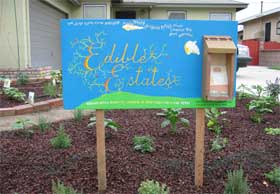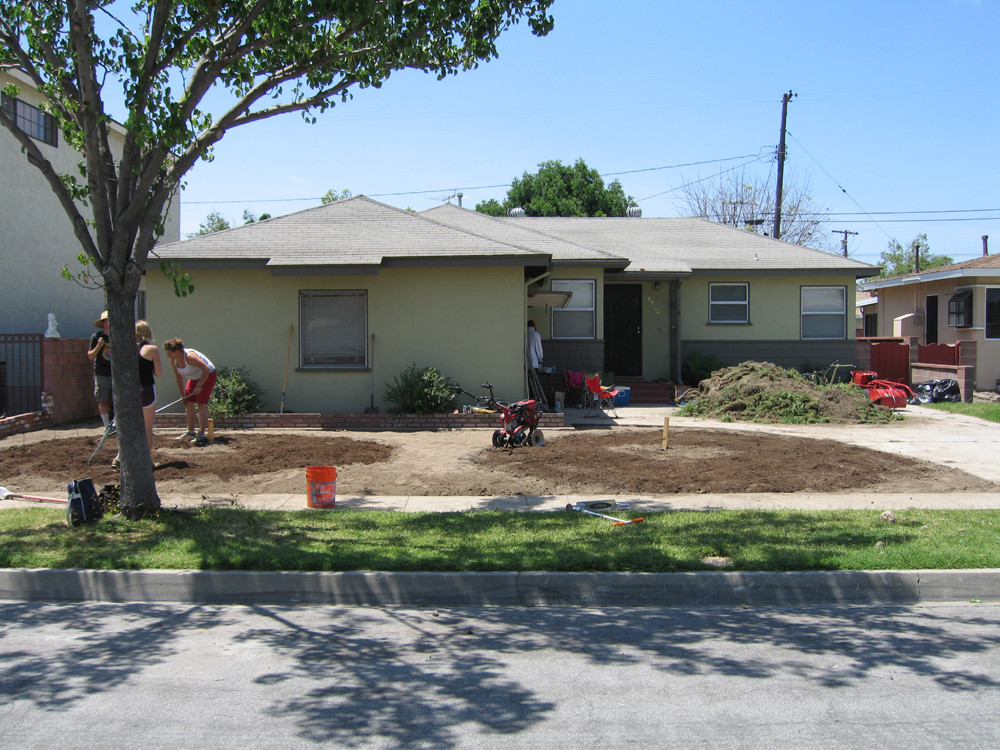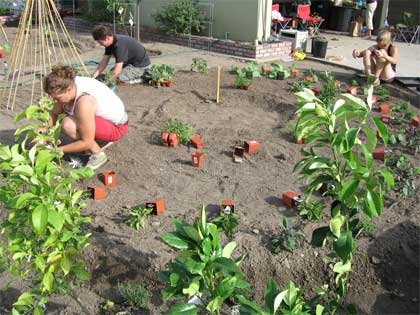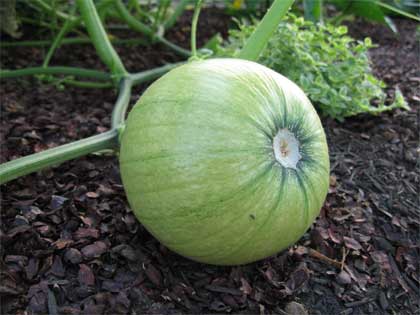 Since 2005, Fritz Haeg‘s project Edible Estates is challenging the American lawn, this “carpet of conformity”, by inviting families to replace their front lawns with food-producing vegetable gardens.
Since 2005, Fritz Haeg‘s project Edible Estates is challenging the American lawn, this “carpet of conformity”, by inviting families to replace their front lawns with food-producing vegetable gardens.
The traditional American front lawn is in fact a British invention. The Rockefellers adopted the style in the mid-1800s for their Kykuit estate, along with other wealthy Americans. By the 1950s, lawns had reached mainstream America. But while in England, frequent rain keeps lawns green, the United States has to rely on sprinklers and fertilizers.
Edible Estates have been planted so far in Salina and Los Angeles, next stop is New York. There’s just a month left until the planting weekend in suburban nyc, but Fritz still has not found the ideal house & family to host the project. I asked him a few questions about the project:
Can you explain to us what are the ingredients that make a house and family the perfect one for the Edible Estate project?
I have posted online a page about our guidelines for these garden which can be found here. It is most important the we find a family of experienced gardeners with a front yard lawn that is part of a street of more of the same. The yard should also be suitable for such a garden, with a flat topography and good solar access. Ideally there would be no mature trees either or any other mature existing landscaping. The idea is to replace the entire front lawn and make the whole front yard a place of food production. For this suburban New York garden in particular I was hoping to find a site that was a bit more urban with families from diverse backgrounds. All materials and labor will be covered by me (with all plants and materials for this New York garden provided by Gardeners Supply Company). The garden will be featured in our upcoming book from Metropolis Books (out Feb. 2008) for which the owners will also contribute a story about their experience with the garden.
 What are the challenges of removing a front lawn and establishing your very own Edible Estate? It must be something quite time-consuming and tricky to maintain if you’re not used to gardening?
What are the challenges of removing a front lawn and establishing your very own Edible Estate? It must be something quite time-consuming and tricky to maintain if you’re not used to gardening?
An edible landscape could be very high maintenance or low depending the proportion of annuals and perennials among other issues. A whole yard of fruit trees and perennial herbs is quite a bit less work than the very dense and diverse garden including plenty of vegetables that we would propose. For this garden it will be an even mix and it will be a fair amount of work and big commitment to keep it going. However, I am only looking for very experienced gardeners who are perhaps already growing their own food in the backyard. Since I view these gardens as regional prototypes it is quite important that the owners be very experienced gardeners, and ideally have spent some time gardening in that particular growing zone. Because this will be a very high-profile garden that is in the FRONT yard, there will be a bit more pressure to have it always looking good. Also, the family would need to be articulate spokespeople for the project and do a fair amount of press about the garden. The Foti family from our most recent garden in Lakewood, California had to meet or talk with people from the press at least a few times a week throughout the first season, including tv, radio and print. I have been quite unprepared for the media interest in the story, but it is an integral part of the project of making this public and getting the story out there so that we may all reconsider how we choose to use our private land.
Edible Estates has been running in several cities so far. Have you found that people are willing to go back to their old lawn. How are neighbours reacting to the transformation of the garden? Does the idea spread throughout the whole area?

After it is planted the garden really is taken over by the owners as their project. The plants and layout may change over the years, but I am asking that they commit to keeping it up and growing food in the front yard as long as they are in the house. These prototype gardens need to be placed in very strategic locations, on streets where this would be very unlikely, and be totally different from anything else around. This dense, diverse and bountiful garden that will also attract butterflies, birds and insects would be a vivid contrast to the surrounding homogeneity and monotony of unused front yards. In areas like this I have found that neighbors can be quite shocked at first to see such a radical change on their street. Any change, even the most benevolent kind can be threatening to many people. But once they see it grow and they see the neighbors tending it every day and they even start to enjoy some of the fruits of it themselves (because often the owners can not eat it all and will give away some produce to their neighbors) they tend to come around. Just to be a witness to this garden growing on your street can make you empathize in powerful ways. Plus you get to know your neighbors better than you ever had in the past. This diffuses a lot of the mystery and makes it ultimately a very humanizing, gracious and community building gesture as much as a source of food.
There is going to be an Edible Estate London. Do you have more plans to conquer Europe?
To be able to do these gardens abroad really requires substantial support from an art or design institution. I have recently been approached by a few other places and hope to do others in Europe in the coming years. I am going to London next week to start planting the garden there which is commissioned by the Tate Modern. It will then be exhibited as part of a show in the Turbine Hall that opens on June 19th. The English gave us the lawn and they are also way ahead of us on considering where our food comes from, so I think it will have a very receptive audience. We will be planting the garden May 24-26 for those in London that want to come help (info(at)edibleestates.org).

I also might add that I am looking for those who are making their own Edible Estates in the United States this season to contribute a before and after picture along with a little story of their experiences for our upcoming book. I will be selected one garden form each of the 10 plant hardiness zones to feature in the book.
Thanks Fritz!







